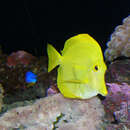Reproduction
provided by EOL authors
There is a strong lunar pattern to reproduction with egg production peaking at the full moon. Females spawn most days, likely greater than 80% at least during the peak reproductive season. Females can produce up to 25,000 eggs per day, with an average adult female producing about 1.1 million eggs per year. Reproductive effort peaks in the late spring and summer, but there is evidence that yellow tang spawn at some level throughout the year. Adult males and females can be identified by the external appearance of the urogential opening. At 13 cm total length and around 5 years old females make a habitat shift from deeper coral rich habitats to shallow turf algal dominate reef flat and boulder habitats. They also start acting like adults in terms of movement patterns and spawign activity, and they start producing substantial amounts of eggs following a lunar cycle. Below this size and age egg production is minimal.
Migration
provided by EOL authors
Each morning, shortly after sunrise, adult yellow tang migrate to shallow turf algae dominated boulder and reef flat habitats to forage over the same few hundred meters squared. These foraging sites are maintained for periods of at least weeks to months. About 1 hour before sunset, they migrate to individual specific spawning locations before moving to nighttime sheltering sites in deeper coral rich and boulder dominated habitats. Yellow tang adults made daily crepuscular migrations of up to 600 m between foraging and spawning or sheltering sites at consistent times relative to sunset and sunrise Yellow tang juveniles are found in deeper coral rich habitats and are site attached with small home ranges throughout this life stage (roughly 4-7 years).
Migration
provided by EOL authors
Each morning, shortly after sunrise, adult yellow tang migrate to shallow turf algae dominated boulder and reef flat habitats to forage over the same few hundred meters squared. These foraging sites are maintained for periods of at least weeks to months. About 1 hour before sunset, they migrate to individual specific spawning locations before moving to nighttime sheltering sites in deeper coral rich and boulder dominated habitats. Yellow tang adults made daily crepuscular migrations of up to 600 m between foraging and spawning or sheltering sites at consistent times relative to sunset and sunrise Yellow tang juveniles are found in deeper coral rich habitats and are site attached with small home ranges throughout this life stage (roughly 4-7 years).
Habitat
provided by EOL authors
Yellow tang settle out of a planktonic larval stage to mid-depth (10 to 25 m) reef habitats that tend to have high coral cover. Adult yellow tang (AYT) transition at around 13 to 15 cm total length to spending their days foraging in shallower (<10 m) turf-algae dominated boulder and reef flat habitats, while sheltering at night in deeper coral rich and boulder habitats. Each morning, shortly after sunrise, adult yellow tang migrate to shallow turf algae dominated boulder and reef flat habitats to forage over the same few hundred meters squared. These foraging sites are maintained for periods of at least weeks to months. About 1 hour before sunset, they migrate to individual specific spawning locations before moving to nighttime sheltering sites in deeper coral rich and boulder dominated habitats.
Life Expectancy
provided by EOL authors
Yellow tang are a long-lived species (the oldest individual collected to date was a 41 year old female).
Size
provided by EOL authors
Yellow tang are sexually size-dimorphic with males being larger than females. Males grow substantially faster than females starting around age 2 and this trend continues until the asymptotic size is approached (age 7 to 10 years). Adult males are typically 17 to 20 cm long, while adult females are typically 14 to 17 cm long.
Growth
provided by EOL authors
Yellow tang are a very long lived species and display the typical surgeonfish "square growth curve", with high initial growth rates that rapidly decrease after the first few years. Yellow tang are sexually size-dimorphic with males being larger than females. Males grow substantially faster than females starting around age 2 and this trend continues until the asymptotic size is approached (age 7 to 10 years). Adult males are typically 17 to 20 cm total length, while adult females are typically 14 to 17 cm total length.

